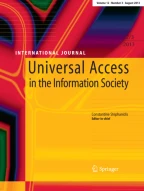Abstract
This paper presents a “Semantic Web application framework” which allows different applications to be designed and developed for improving the accessibility of the World Wide Web (WWW). The framework promotes the idea of creating a community of people federating into groups (ontology creators, annotators, user-agent developers, end-users) each playing a specific role, without the coordination of any central authority. The use of a specialised voice web browser for blind people, called SeEBrowser, is presented and discussed as an example of an accessibility tool developed based on the framework. SeEBrowser utilises annotations of web pages and provides browsing shortcuts. Browsing shortcuts are mechanisms, which facilitate blind people in moving efficiently through various elements of a web page (e.g. functional elements such as forms, navigational aids etc.) during the information-seeking process, hence operating effectively as a vital counterbalance to low accessibility. Finally, an experimental user study is presented and discussed which evaluates SeEBrowser with and without the use of browsing shortcuts.
Similar content being viewed by others
References
Horton, S.: Designing beneath the surface of the web. W4A: Proceedings of the 2006 international cross-disciplinary workshop on Web accessibility (W4A), pp. 1–5 (2006)
Leventhal, A.: Structure benefits all. W4A: Proceedings of the 2006 international cross-disciplinary workshop on Web accessibility (W4A), pp. 33–37 (2006)
Marshall, C., Shipman, F.M.: Which semantic web? HYPERTEXT ‘03: Proceedings of the fourteenth ACM conference on Hypertext and hypermedia, pp. 57–66 (2003)
Kouroupetroglou, C., Salampasis, M., Manitsaris, A.: A Semantic-web based framework for developing applications to improve accessibility in the WWW. W4A: Proceedings of the 2006 International cross-disciplinary workshop on Web accessibility (W4A), pp. 98–108 (2006)
Google Code: web authoring statistics (2006) http://code.google.com/webstats/index.html
Salampasis, M., Kouroupetroglou, C., Manitsaris, A.: Semantically enhanced browsing for blind people in the WWW. HYPERTEXT ‘05: Proceedings of the sixteenth ACM conference on Hypertext and hypermedia, pp. 32–34 (2005)
Parmanto, B., Ferrydiansyah, R., Saptono, A., Song, L., Sugiantara, I., Hackett, S.: AcceSS: accessibility through simplification and summarization. W4A ‘05: Proceedings of the 2005 International cross-disciplinary workshop on web accessibility (W4A), pp. 18–25 (2005)
Harper, S.: Web mobility for visually impaired surfers. PhD thesis, The University of Manchester (2001)
Goble, C., Harper, S., Stevens, R.: The travails of visually impaired web travelers. In: Proceedings of the eleventh ACM on Hypertext and hypermedia, pp. 1–10 (2000)
Yesilada, Y., Stevens, R., Goble, C.: A foundation for tool based mobility support for visually impaired web users. Paper presented at the Proceedings of the twelfth International conference on World Wide Web 2003
Takagi, H., Asakawa, C., Fukuda, K., Maeda, J.: Site-wide annotation: reconstructing existing pages to be accessible. In: Proceedings of the fifth International ACM conference on assistive technologies, pp. 81–88 (2002)
Huang, A., Sundaresan, N.: A semantic transcoding system to adapt Web services for users with disabilities. In: Proceedings of the fourth International ACM conference on assistive technologies, pp. 156–163 (2000)
Hanson, V., Richards, J.: Achieving a more usable WorldWide Web. Behav. Inf. Technol. 24, 231–246 (2005)
Annotea project (2006) http://www.w3.org/2001/Annotea/
Gruber, T.: A translation approach to portable ontology specifications. Knowl. Acquis. 5, 199–220 (1993)
Tektonidis, D., Bokma, A., Oatley, G., Salampasis, M.: ONAR: an ontologies-based service oriented application integration framework. 1st International conference on interoperability of enterprise software and applications (2005)
The Protégé ontology editor and knowledge acquisition system (2006)http://protege.stanford.edu/
Jena Semantic web framework (2006) http://jena.sourceforge.net/
SeEBrowser project (Archimedes) (2006) http://seebrowser.it.teithe.gr/
Xydas, G., Kouroupetroglou, G.: The DEMOSTHeNES speech composer. 4th ISCA tutorial and workshop on speech synthesis (SSW4), pp. 167–172 (2001)
Mukherjee, S., Ramakrishnan, I., Kifer, M.: Semantic bookmarking for non-visual web access. In: Proceedings of the ACM SIGACCESS conference on computers and accessibility, pp. 185–192 (2004)
Ramakrishnan, I., Stent, A., Yang, G.: Hearsay: enabling audio browsing on hypertext content. In: Proceedings of the 13th international conference on World Wide Web, pp. 80–89 (2004)
Mobasher, B., Cooley, R., Srivastava, J.: Automatic personalization based on Web usage mining. Commun. ACM 43, 142–151 (2000)
Acknowledgments
The research project is funded by the E.U. and the Greek Ministry of Education under the research program “Archimedes” [19]. We would also like to thank Dimitris Tektonidis for his contribution to the project regarding the development of ONAR, and Marios Chatzidimitriou for the development of the annotation storage server software.
Author information
Authors and Affiliations
Corresponding author
Rights and permissions
About this article
Cite this article
Kouroupetroglou, C., Salampasis, M. & Manitsaris, A. Browsing shortcuts as a means to improve information seeking of blind people in the WWW. Univ Access Inf Soc 6, 273–283 (2007). https://doi.org/10.1007/s10209-007-0090-z
Published:
Issue Date:
DOI: https://doi.org/10.1007/s10209-007-0090-z
